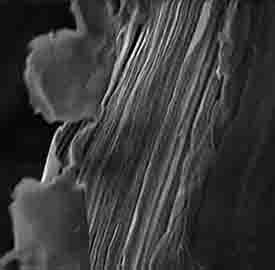Associate Professor Jiaxing Huang of Northwestern Engineering has developed a stable proton-conducting system using a stack of clay sheets.
“We used a clay that you can buy at a gardening store,” said Huang, associate professor of materials science and engineering at Northwestern’s McCormick School of Engineering. “I like to call it a ‘down-to-earth’ material.”
 A scanning electron microscopy image of Huang's stacked clay sheets.
A scanning electron microscopy image of Huang's stacked clay sheets.
Protons generate an electric current when they are transported, and this current plays an important role in technology, and in nature. Harnessing of proton conduction holds significant interest among engineers for various applications including harvesting of energy, electrochemical reactors and sensors, and catalysis. As an example, chemical energy has to be converted into electricity in fuel cells. In this case, a proton has to reach a cathode, and for that it has to be transported across a membrane.
Membrane proteins form nanopores in cells through which proton transportation can be done. Engineers have attempted to create artificial proton nanochannels by replicating this phenomenon. Nanolithography has been used for creating nanochannels in various materials including glass and silicon to improve conductivity and ionic transport. Though higher conductivity has been realized, it is difficult to implement it on a large scale, and the nanolithography process is costly and complicated.
Many types of nanochannels have been demonstrated on a substrate. But it has been difficult to produce them in large quantities, say, a substrate filled with nanochannels.
Associate Professor Jiaxing Huang
The new solution developed by Huang makes use of the advantageous natural properties of clay. Vermiculites are 2D sheets of clay. Negative charges are carried by these sheets when they are exfoliated in water. These sheets attract protons that are positively charged due to their negative charges. These sheets self-assemble themselves into paper-like films after they dry. These layers have a nearly 1nm spacing between them, and function as nanochannels for concentrating protons for conduction.
Clay layers demonstrate considerable advantages when compared to other 2D materials and graphene-based sheets, when they are used for fabricating ion conducting materials and devices. Furthermore clay is readily available and through ionic exchange it can be exfoliated in water. Other materials including graphene require chemical exfoliation, that is comparatively less benign. Additionally, clay demonstrates very high thermal and chemical stability, and can withstand temperatures exceeding 500°C.
Clay has extraordinary thermal stability. We want to create a proton conducting system that can sustain very high temperatures because some of the best proton-conducting materials out there can’t do that.
Associate Professor Jiaxing Huang
The material processing techniques needed for creating 2D nanochannels can be easily scaled up due to their simplicity. Hence, in the clay membrane produced by Huang, more than 30% of its volume is composed of nanochannels that conduct protons.
Huang considers the clay membrane as a type of “bulk nanostructured material.” These are macroscopic material forms that have nanoscale structural units. Bulk nanostructure materials have unique properties that are not tenable to their nanoscale structural units.
In Huang's clay membrane, the individual clay sheets do not possess any properties for conducting protons. When the materials final bulk form has to be generated the clay sheets have to be assembled face-to-face, and this would enable all the sheets to support properties for conduction of protons.
This research paper has been published in Nature Communications. Other authors who contributed to this study include Kalyan Raidongia, a former postdoctoral scholar; Andrew Koltonow, a graduate student; and Jiao-Jing Shao, a former visiting student.
Northwestern’s Materials Research Science and Engineering Center, and the Office of Naval Research have supported this study.
References